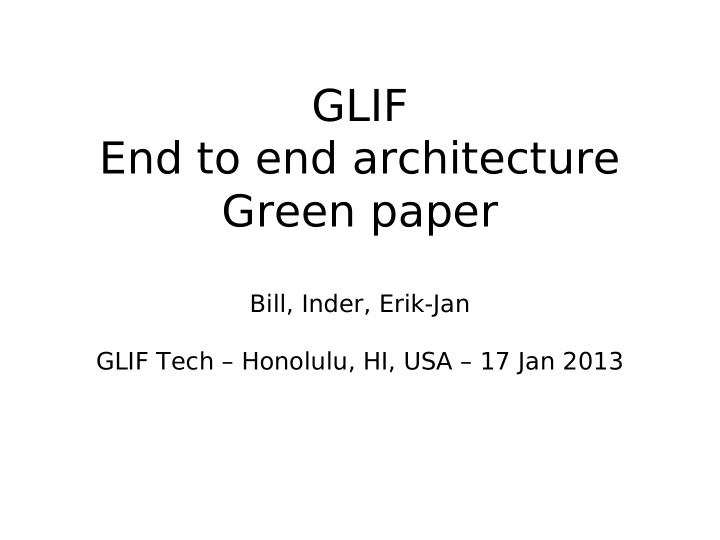



GLIF End to end architecture Green paper Bill, Inder, Erik-Jan GLIF Tech – Honolulu, HI, USA – 17 Jan 2013
Green Paper • EC uses the concept of a green paper: A green paper released by the European Commission is a discussion document intended to stimulate debate and launch a process of consultation, at European level, on a particular topic. A green paper usually presents a range of ideas and is meant to invite interested individuals or organizations to contribute views and information. It may be followed by a white paper, an official set of proposals that is used as a vehicle for their development into law.
Context of Green Paper • GLIF has been a huge success – Connects over 55 countries, thousands of universities and tens of thousands researchers and educators • GLIF and GLORIAD only global organizations dedicated to deploy international infrastructure to support global big science and data and collaboration • NSI is now in production • GOLEs are now deployed across virtually all continents • What next?
End to end architecture • As agreed upon at Rio and Chicago meetings • Currently GLIF is a NREN to NREN construct. How do we truly develop an end to end architecture right to the application (or user)? • Taking into consideration following developments: – User applications versus traffic engineering – SDN networks – Multi-domain issues
What is GLIF role and next steps? • What role should GLIF take to realize vision of end to end architecture – Set up working task force with contributions from participants? – Report on related work or activities by participants and how it relates to end to end architecture? – Coordinate work amongst participants? – Develop appropriate working groups within IETF or OGF,etc? – Wait and see?
Hand over to Erik-Jan
User Profiles (2.1) • Small and Medium Science Users (2.1.1) Individual requirements → IP routed; campus − and backbone level → BoD • Big Science Users (2.1.2) 10Gs and beyond, especially in need for − performance tools • Guinea Pig Users (2.1.3) Users willing to suffer (a little) in return for − advanced service s
Lightpath Applications for small and medium science (2.2) • Global Tier 1 Peering Applications (2.2.1) – Bringing global peering to NRENs, increasing quality and lowering costs • R&E Content Distribution Network (2.2.2) – Examples include LHCONE and CineGrid content distribution • Cloud Applications (2.2.3) – Important for R&E, example AWS' 10G VPN servic e
Lightpath applications Big Science (2.2) • Big Data Applications (2.2.4) – The usual suspects, new developments like ScienceDMZ • Large Sensor Applications (2.2.5) – Using predefined topologies for big data streams, e.g. SKA or LOFAR • Low carbon emission apps (2.2.7) – Bring computing and storage resource in a “green” way, e.g. GreenQloud
Lightpath Applications – Guinea Pig • Experimental Testbeds (2.2.8) – Supplying bandwidth to testbeds, e.g. for GENI • Private Lightpath or SDN networks across Multi-domain optical networks (2.2.9) – Optical Private Networks (in every form or shape)
Hand over to Inder
Discussion and Next Steps What are people interested in that they can bring together under the GLIF umbrella? • Four possible cases based on use cases • Maybe more or less
Discussion and Next Steps Developing Bandwidth on Demand and Traffic Engineering toolsets that use both NSI and SDN but interoperate with (G)MPLS-TE? • Use case: Provide the GLIF lightpath circuit with new set of network technologies, hopefully moves it end-to- end • An architecture white paper that includes all protocols • Prototype, Demo, Deployment
Discussion and Next Steps Integrating lambda and SDN networking within applications that are routable, discoverable and scalable at Internet layer 3 and layer 2 • Use case: IP networking works over legacy and with SDN domains • OpenFlow testbeds – • International ones
Discussion and Next Steps Developing inter-domain and multi-domain SDN for both the forwarding, control and management planes. • No discussion • SDN inter-domain WG
Discussion and Next Steps Content, Storage and its intersection with Networking • Use-case: R&E CDNs
Thank you. Bill, Erik-Jan, Inder
Recommend
More recommend